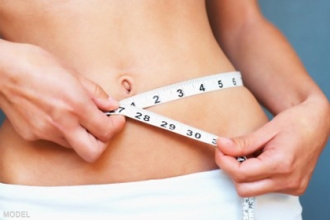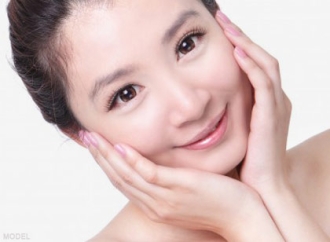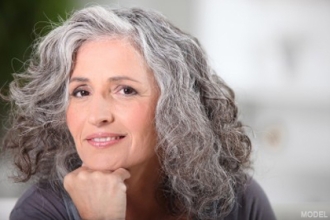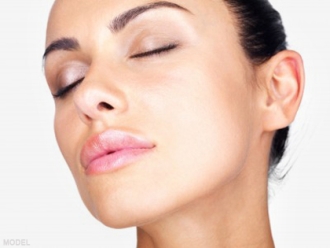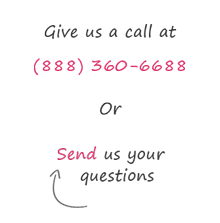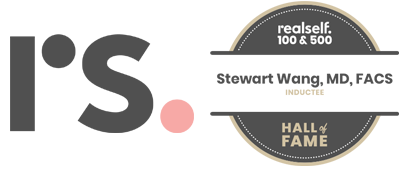The Eyelid Lift, or Upper Eyelid Surgery (Upper Blepharoplasty) procedure are the restoration of the correct functioning to the affected eyelid(s), and the restoration of the aesthetics of the eye-region of the face, which are achieved by eliminating excess skin from the upper eyelid(s), usually caused by age-related changes.
Though eyelid surgery is most common among those who are 35 or older, it can be performed on healthy, emotionally stable individuals of all ages. There are, however, some conditions that make eyelid surgery more risky. They include hypothyroidism, Graves' disease, insufficient tearing of the eyes, high blood pressure, circulatory disorders, cardiovascular disease, diabetes, a detached retina and glaucoma. You will want to discuss your medical history with Dr. Wang during your consultation prior to making your decision about eyelid surgery. Often, best results may be obtained with a combination of lower eyelid surgery, brow lift, or mid-facelift.
What are the common benefits of upper eyelid surgery?
Eyelid surgery corrects sagging or drooping eyelids and rejuvenates your upper eyelids. It can also relieve vision problems caused by these conditions.
How is Pasadena eyelid surgery performed?
While the patient is under local anesthesia, Dr. Wang makes incisions in the creases of the upper lids. Through these incisions, Dr. Wang separates the skin from fatty tissue and muscle, removes excess fat and trims sagging skin and muscle. Once excess fat, skin, etc. has been removed, Dr. Wang closes the incision with very fine sutures.
How long does eyelid surgery take?
Eyelid surgery usually takes from one to three hours.
What can I expect after eyelid surgery?
After the procedure, Dr. Wang is likely to lubricate your eyes with ointment and apply a bandage. Stitches will be removed two days to a week after surgery. You may experience soreness and tightness in your eyelids that can be relieved with medication as prescribed by Dr. Wang. You will be required to keep your head elevated and use cold compresses for several days to reduce swelling and bruising. You are also likely to experience excessive tearing, sensitivity to light and temporary changes in your vision.
What is the recovery period like?
During recovery back home in Pasadena or Riverside, your eyes may feel gummy for a week or so. Dr. Wang will show you how to clean your eyes. Dr. Wang may also recommend eye drops to relieve dryness, burning or itching. You should be able to watch television or read within two or three days. You will want to avoid contact lenses for about two weeks or until they begin to feel more comfortable. It is, however, recommended that you wear sunglasses and a sun block for eyelids to reduce sensitivity to the sun, wind and other irritants. Scars may remain slightly pink for six months or more, but will fade to a nearly invisible white line. Read Dr. Wang's advice about recovery from surgery.
How long before I can return to normal activity?
Dr. Wang may advise you to minimize your activities for three to five days and to avoid more strenuous activities — particularly those that raise your blood pressure — as well as alcohol, for about three weeks.
If you believe that your eyes are making you look tired, sad, or older than you really feel, cosmetic eyelid surgery (also called blepharoplasty) may be the right choice for you. Eyelid surgery can remove the excess fat and drooping skin of the upper eyelids, minimize bags under the eyes and tighten the lower eyelid skin. The result is a more alert and rested appearance.
Liposuction is a popular cosmetic option for women and men who want to remove excess fat from areas of the body and face. Laser technology improves upon the accuracy and quality of results and gives Dr. Stewart Wang the ability to enhance outcomes for patients considering liposuction in the Pasadena or Riverside, CA areas.
Many people know laser liposuction by the brand names Smartlipo® and ProLipo™. For his laser lipo procedures, Dr. Wang uses the latest generations of both Smartlipo® Triplex from Cynosure® and AccuSculpt™ (AccuLift™) Laser Lipo-Sculpting System from Lutronic®. Both Smartlip and AccuLift offer specialized wavelength for enhanced safety, speed and efficiency during fat reduction. Laserlipo uses small incisions and transmits select or a combination of laser energy to rupture fat cells, which then can be suctioned out or removed by your body naturally over time. The precise laser beam targets fat cells while minimizing heating of surrounding tissues
Dr. Wang is the first doctor in Pasadena and Inland Empire to offer both Smartlipo and AccuSculpt for advanced body contouring. He believes that the combination offers a number of advantages for his patients who want to improve their body shape. In fact, it may be more accurate to refer to the procedure as "liposculpture" because of the precise sculpting that can be performed, based on the patient’s body shape and fat density, and the treatment area.
If you're ready to discuss laser liposculpture in more detail, now is a great time to schedule a consultation with Dr. Wang at our plastic surgery offices, serving Southern California including Pasadena, Arcadia and Riverside. You can request a consultation online or call Wang Plastic Surgery at 866.486.9149 today to schedule your appointment.
In addition to laser liposuction, Dr. Wang also offers traditional liposuction techniques including tumescent, ultrasound-assisted lipoplasty (UAL), power-assisted lipoplasty (PAL) and the super-wet technique. In your initial consultation, Dr. Wang will recommend a technique that is best for you, based on the location of your fat deposits and the condition of your skin.
What are the benefits of laser liposculpture?
Laser-assisted liposuction offers a number of advantages over traditional techniques for certain patients. These advantages include:
- Improved accuracy: The laser allows Dr. Wang to very precisely sculpt excess fat for custom-tailored results.
- Easier treatment: The laser rapidly passes through connective tissue, requiring less effort during surgery.
- Easier recovery: Because less surrounding tissue is disrupted, recovery is quicker and more comfortable.
- Enhanced safety: AccuSculpt can remove fat with less trauma to patients, providing a safer procedure.
How does AccuLift compare to Smartlipo Triplex?
While both devices utilize similar technology, the latest generations utilize a combination of wavelengths. Based on the treatment area and Patient’s condition, Dr. Wang will determine the use of either Smartlipo or AccuLift to deliver a more reliable and satisfying result of the patient. Selection of the wavelength of light is critical to maximize fat reduction while minimizing adverse effects on surrounding tissue, and less downtime.
How is laser liposuction performed?
The addition of laser technology does not dramatically change how liposuction is performed. After local, regional or general anesthesia is administered, small incisions are made through which Dr. Wang inserts the specially-designed AccuSculpt wand to break up the fat cells.
What can I expect after my procedure?
As with traditional liposuction techniques, some pain, burning, swelling, stiffness, bleeding and temporary numbness may occur. Dr. Wang can prescribe pain medication or antibiotics as needed for your comfort. To enhance results and keep the skin looking tight and firm, you may need to wear a snug elastic garment over the treated area for a few weeks.
What is the recovery period like?
Generally, laser lipo patients recover quickly, and begin to feel like themselves again in a week or two. Most swelling and bruising will resolve within 3 weeks. Strenuous activities should be avoided for about a month so that your body has time to heal. Read Dr. Wang's advice about recovery from surgery.
How long before I can return to normal activity?
You should be able to return to work within a few days after surgery, but Dr. Wang will advise you about when you can add exercise and more strenuous activity back into your daily routine.
The information about Laser Liposuction is provided for Riverside and Pasadena, CA area residents courtesy of Dr. Stewart Wang, a board certified plastic surgeon.
Many people have baggy lower eyelids or puffy eye bags due to genetics or signs of aging. The cause of bagginess and puffiness of the lower eyelid is generally due to a combination of herniating fat, excessive skin, and edema (water retention).
Asian Double Eyelid Surgery (Asian Blepharoplasty) is a blepharoplasty procedure used to create a supratarsal epicanthic fold in the upper eyelid of the patient who lacks such a crease. The supratarsal epicanthic fold is common to most ethnic groups, but is absent in approximately 50% of the Asian population.
Placing or replacing a fold in the upper eyelids will give patients bigger, brighter eyes. The procedure is highly sought after by patients who desires to enhance the symmetry of the eyes with natural-looking creases that are suitable for Asian's facial features.
Dr. Wang, with plastic surgery offices in Pasadena and the Inland Empire, is highly experienced in Asian Double Eyelid Surgery. Based on the shape, size and width of your eyes, distance between your brows and eyes, fat density underneath your eyelid, skin elasticity, height of your nose bridge, and your facial structure, Dr. Wang will discuss the double eyelid surgery options with you.
Whether it's the suture or incision, including the full-incision, partial incision and no incision methods (e.g. the DST method), for the crease formation, height of the crease, removal of excess skin or fat, the Asian double eyelid surgery should vary by patient's anatomy and desire. If you think you're ready to discuss your Asian Blepharoplasty options, now is a good time to request a consultation online or call Wang Plastic Surgery at (888) 360-6688 today to schedule your appointment.
How long does Asian double eyelid surgery take?
Eyelid surgery usually takes from one to three hours.
What can I expect after Asian double eyelid surgery?
After the procedure, Dr. Wang is likely to lubricate your eyes with ointment and apply a bandage. Stitches will be removed two days to a week after surgery. You may experience soreness and tightness in your eyelids that can be relieved with medication as prescribed by Dr. Wang. You will be required to keep your head elevated and use cold compresses for several days to reduce swelling and bruising. You are also likely to experience excessive tearing, sensitivity to light and temporary changes in your vision.
What is the recovery period like?
During recovery back home in Pasadena or Riverside, your eyes may feel gummy for a week or so. Dr. Wang will show you how to clean your eyes. Dr. Wang may also recommend eye drops to relieve dryness, burning or itching. You should be able to watch television or read within two or three days. You will want to avoid contact lenses for about two weeks or until they begin to feel more comfortable. It is, however, recommended that you wear sunglasses and a sun block for eyelids to reduce sensitivity to the sun, wind and other irritants. Scars may remain slightly pink for six months or more, but will fade to a nearly invisible white line. Read Dr. Wang's advice about recovery from surgery.
How long before I can return to normal activity?
Dr. Wang may advise you to minimize your activities for three to five days and to avoid more strenuous activities — particularly those that raise your blood pressure — as well as alcohol, for about three weeks.
A forehead lift corrects the sagging or low position of the eyebrows, softens horizontal creases across the forehead and erases the worried or angry expression that can result from frown lines. The outcome is a more relaxed and refreshed appearance.
Now is a great time to schedule a forehead lift consultation with Dr. Wang at our plastic surgery offices, serving Southern California including Pasadena, Arcadia and Riverside. You can request a consultation online or call Wang Plastic Surgery at (888) 360-6688 today to schedule your appointment.
With endoscopic brow lift plastic surgery in the Inland Empire / Pasadena, Dr. Wang uses a flexible, pencil-sized instrument to microsurgically tighten the muscles of the brow, which lifts sagging folds of skin. The brow lift can also be performed in combination with the eyelid lift to significantly reduce skin overhang in the upper eyelid. Dr. Wang evaluates your face to determine if eyelid surgery is also necessary, and will make recommendations specific to your situation. In many cases, eyelid surgery is not necessary.
Forehead lifts are most common among those between the ages of 40 and 60, though they can be performed on healthy individuals of any age. Forehead lifts can also be performed in combination with facelifts for an overall smoother appearance of the face.
What are the common benefits of a forehead lift?
The forehead lift smoothes the forehead, raises the eyebrows and minimizes frown lines.
How is the forehead lift performed?
Prior to the procedure, the hair is tied back and trimmed behind the hairline where the incisions will be made. While the patient is under local anesthesia, Dr. Wang makes three to five short scalp incisions that are less than an inch long. Dr. Wang then inserts the endoscope through one of the incisions for a clear view of the muscles and tissues beneath the skin. For a smoother appearance, the forehead skin is lifted and the underlying muscles and tissue removed or altered with an instrument inserted through a different incision. At this time, the eyebrows may also be lifted and secured at a higher position with sutures beneath the surface of the skin or with temporary fixation screws behind the hairline. When the lift is complete, the incisions are closed with stitches or clips. The area is then washed and Dr. Wang may add gauze and a bandage.
How long does a forehead lift take?
The endoscopic forehead lift takes from one to two hours.
What can I expect after my Pasadena / Riverside plastic surgery?
After surgery, you may experience fatigue, numbness, pain and mild swelling. Within about three weeks, though, most of the obvious signs of surgery will fade and you will appear more rested. Read Dr. Wang's advice about recovery from surgery.
What is the recovery period like?
During recovery, stitches or clips are typically removed within a week and temporary fixation screws are removed within two weeks. You should be able to shower and shampoo your hair within two days or after the bandage is removed. You should limit vigorous physical activity for several weeks. This includes activities that increase your blood pressure, like jogging, bending, heavy housework and sex. You should also limit your exposure to sun for several months. Read Dr. Wang's advice about recovery from surgery.
How long before I can return to normal activity?
Most patients who have experienced forehead lifts should be mobile within two days, but should take it easy for at least the first week after surgery. Most patients can return to work in a week to 10 days.
The information about Forehead Lifts is provided by Pasadena and Inland Empire plastic surgeon Dr. Stewart Wang, who is certified by the American Board of Plastic Surgery.
The mid-facelift revitalizes one's appearance by targeting the middle third of the face and therefore creating a more youthful effect. This region, from the lower eyelids to the upper lip, often shows signs of aging such as sagging cheeks, droopiness below the eyes, and deepened laugh lines. While the traditional facelift targets the lower face and neck, the mid-facelift concentrates on this middle section of the face. This procedure is often performed in connection with a browlift or lower eyelid surgery in order to provide overall rejuvenation. A consultation with Dr. Wang will help you in deciding if the mid-facelift may be the best option for refreshing your look.
If you're ready to discuss your mid-facelift options, now is a great time to schedule a consultation with Dr. Wang at our plastic surgery offices, serving Southern California including Pasadena, Rancho Cucamonga, Glendora, Chino Hills, Arcadia and Upland. Simply request a consultation online or call Wang Plastic Surgery at (888) 360-6688 today to schedule your appointment.
What is a mid-facelift?
The mid-facelift is either an open or endoscopic procedure for raising the soft tissues of the cheeks in order to create a youthful vitality. The fat of the upper cheeks (malar pads) sink with age, which then causes hollowness beneath the eyes and increases the depth of the folds that extend from the lower part of the nose to the corners of the mouth (nasolabial folds). Through an endoscopic approach with small incisions concealed within the hairline, Dr. Wang lifts the fat pads of the upper cheeks as well as the deeper facial tissues in this region to an elevated position.
Who is the ideal candidate for a mid-facelift?
The ideal candidate for this procedure is one with realistic expectations who is looking to enhance rather than transform their appearance. Because sagging in the middle third of the face begins in the late thirties, candidates for this procedure are generally in their forties and up.
How is the incision made?
In performing a mid-facelift Dr. Wang makes short incisions within the hairline near the temple. This allows for use of special tools to lift the fat and tissues, which are then secured in place with absorbale sutures. The incisions are very small and therefore practically unnoticeable. The external closures are removed about a week or so after surgery. The procedure is can be performed with the patient under either local or general anesthesia.
What is the typical recovery time?
Most patients are able to return to their regular lifestyle about a week after the procedure. Bruising and swelling can occur, especially within the first week. Elevating the head and icing the area can help alleviate swelling. Pain medication is used to address slight discomfort immediately following the procedure.
The information about Mid-Facelift is provided by Pasadena and Inland Empire plastic surgeon Dr. Stewart Wang, who is certified by the American Board of Plastic Surgery.
As we age, gravity causes fat deposits to migrate downward in the face, creating under-eye bags, sagging cheeks and jowls, and loose skin in the chin and neck. For Pasadena residents wanting a facial rejuvenation option that's minimally invasive, AccuLift™ laser lipolysis removes unwanted fat deposits and tightens loose skin, restoring a more youthful appearance to the aging face.
AccuLift appeals to many patients and surgeons because it carefully balances the benefits of a non-invasive treatment with the benefits of surgery. Non-surgical treatments can have temporary and sometimes variable results; unfortunately, the surgical procedures that can achieve permanent, consistent results often require a lengthy recovery period. AccuLift, however, provides lasting, significant improvement without the discomfort or downtime of surgery.
AccuLift laser lipolysis can also serve as a perfect complement to other facial plastic surgery procedures and non-surgical rejuvenation treatments. Dr. Wang will work closely with you to customize a treatment plan specific to your facial characteristics and treatment goals.
If you're interested in speaking with Dr. Wang about AccuLift facial liposuction at our Pasadena or Inland Empire plastic surgery locations, simply request a consultation online or call Wang Plastic Surgery at (888) 360-6688 today.
What are the benefits of AccuLift facial rejuvenation?
AccuLift restores the aging face to a more youthful appearance by removing unwanted fat deposits and tightening loose skin. In contrast to other surgical facial rejuvenation treatments, AccuLift:
- Offers immediate results
- Requires minimal downtime
- Uses local anesthesia only
- Requires only one brief treatment
How is the AccuLift procedure performed?
First, Dr. Wang applies a small amount of local anesthesia to numb the treatment areas. Next, he creates small 1 to 2 mm openings at the edge of the treatment area. Through these tiny openings, the AccuSculpt™ laser removes fat and tightens skin.
How long will the AccuLift procedure take?
Most AccuLift procedures can be completed in less than one hour.
What can I expect after the AccuLift procedure?
Immediately after the procedure, the treated area will appear tighter and slimmer. Skin tightening is a gradual process, showing continual improvement over time. Best results are visible after several months. Because the procedure uses only tiny incisions and incision lines fade gradually over time, scarring (if any) is minimal.
What is the recovery period like?
The recovery period is relatively brief, typically with very little swelling or bruising. Patients can expect low levels of discomfort for the first 24 to 48 hours following surgery.
How long before I can return to normal activity?
Most patients are able to return to their daily routine within 2 to 5 days.
The information about AccuLift™ facial rejuvenation is provided for Pasadena and Riverside area residents courtesy of Dr. Stewart Wang, a board-certified plastic surgeon.
Silhouette Lift® is an innovative, non-invasive facelift procedure that is FDA approved for use in the US. The Silhouette Lift is a gentle alternative to a standard facelift. Without the use of a scalpel, without any cutting or pulling, with reduced scarring and minimal recovery time, and without the need for general anesthesia, the Silhouette Lift creates a natural looking lift by elevating and fixating the tissues of the mid-face, brow and neck with barbed polypropylene threads. The Silhouette Lift® can achieve 60-70% of the results of a conventional facelift and can be re-adjusted over time for additional enhancement as the aging process continues.
Kissable full lips together with an elegant jaw line define an alluring facial profile. The chin is a critical element of the aesthetic proportions and symmetry of a face. While plump lips will add fullness and definition to the face. Permanent chin and lip implants can enhance your facial balance and harmony.
Now is a great time to schedule a Lips or Chin Augmentation consultation with Dr. Wang at our plastic surgery offices, serving Southern California including Pasadena, Arcadia and Riverside. You can request a consultation online or call Wang Plastic Surgery at (888) 360-6688 today to schedule your appointment.
Chin enhancement, chin reshaping, or chin augmentation can be surgically achieved by chin implants, often called genioplasty or mentoplasty, which strengthens the appearance of a “weak” or receding chin by increasing its projection. Another possibility for improvement through chin surgery is laser liposuction in which excess fatty tissue is removed to redefine the chin or jawline.
Chin augmentation, or genioplasty, is fast becoming one of the most efficient methods of enhancing one’s look. Changing the contour of the chin can help create a stronger jaw line, balance out facial features, and improve facial symmetry. For those looking to achieve such enhancements, Dr. Wang is highly skilled in performing several chin augmentation procedures. He offers both a non-invasive technique as well as surgical procedures involving either the insertion of a chin implant or the repositioning of the patient’s chin bone. These methods are often performed in combination with other facial procedures. Patients undergoing a nose surgery (rhinoplasty), for example, or a facelift (rhytidectomy) may also opt for genioplasty in achieving a balanced overall aesthetic.
Is there a non-invasive option for Lips and Chin Enhancements?
For patients seeking a non-invasive, in-office procedure, the injection of a soft tissue filler is an excellent option. Dr. Wang uses Radiesse, a semi-permanent injectable filler that stimulates the body’s own collagen production process, to add volume to the chin area. The results are instant and last about a year.
What is chin implantation?
For those seeking a more permanent enhancement, Dr. Wang may perform chin implantation surgery. An implant is placed on top of the chin bone to help enhance a receding chin, make the chin wider, or even lengthen the face somewhat. Implants are available in a variety of sizes, shapes, and materials, depending on the desired goal and the technique utilized.
What is chin repositioning (osteotomy)?
Instead of using a chin implant, Dr. Wang may choose to perform osteotomy, which involves repositioning the patient’s own chin bone. This can be done in order to correct a short chin or to shorten or narrow the chin. An incision is made inside the mouth so that the bone can be cut, repositioned, and then wired into place.
How is the incision made?
The incision choice depends on the type of procedure and the surgeon’s preference. This choice also depends on the type of implant selected and the desired effect. With osteotomy, the incision is made inside the mouth between the lower lip and gum. For implant placement, either an internal or external incision can be used in order to create a pocket for the implant to be placed between the bone and the chin tissue. With both approaches, light anesthesia or general anesthesia can be used, depending on the choice made by Dr. Wang and the patient.
What is the typical recovery time?
Recovery time after undergoing genioplasty depends on the particular approach used and also whether or not other procedures were performed simultaneously. Patients who undergo genioplasty alone generally find it easy to return to light activities shortly after the procedure. A chin sling or wrap is usually used for several days following surgery in order to provide support.
With the oral incision option, patients are restricted to a liquid or soft diet for several days in order for the gums to heal. Sutures dissolve on their own after several weeks. If an external incision is made, sutures are removed in office after several weeks.
Patients who opt for chin implantation often experience “tightness” in the chin area due to the newly added implant and because of the body’s own swelling reaction to surgery. This mild discomfort is generally lessened by the use of oral pain-relieving medications, which are usually needed for a few days after surgery. Bruising generally improves within seven to ten days.
What kind of complications can occur?
Scarring – No visible external scars are present when the incision is made inside the mouth. A very small, easily concealable scar will likely be present if the incision is made externally.
Side Effects – Immediately following surgery, patients experience a sense of their chin being “asleep” due to the effect of the anesthesia. This effect usually wears off shortly after the procedure. Those who undergo osteotomy may experience a temporary loss of feeling of the lip and chin that may take several weeks to months to wear off.
This is why it is important to wear the chin support for the fully recommended period and to avoid contact activities until fully healed. In the event that the chin implant somehow becomes infected, removal may be necessary in order to clear the infection.
Although many patients choose to focus on the face in enhancing their appearance, it is often necessary to address the neck area, which is crucial for maintaining a healthy, youthful look. Patients seeking to define the contour of the neckline may consider a neck lift, which includes one or more surgical techniques depending on the patient’s individualized needs. Sagging of the neck muscles and loosening of the skin often occur as part of the aging process, but can also be hereditary or can result from significant weight loss. During a neck lift, Dr. Wang may choose to use one technique or a combination, which depends on the individual's anatomy and goals. A neck lift can be performed as a stand-alone surgery, but is often done in conjunction with a facelift to create a truly revitalized appearance.
Now is a great time to schedule your neck lift consultation with Dr. Wang at our plastic surgery offices, serving Southern California including Pasadena, Arcadia and Riverside. You can request a consultation online or call Wang Plastic Surgery at (888) 360-6688 today to schedule your appointment.
What does a neck lift entail?
One component of the surgery is cervicoplasty, which involves cutting, removing, lifting, and suturing of the skin in the neck area. Platysmaplasty involves tightening the underlying neck muscles (platysma) by pulling them together and affixing them with permanent sutures. This is especially effective for eliminating the formation of lines, or bands, as they are often called, in the neck area. These bands usually form due to loosening of the muscles along the neck. Liposuction of excess fat in the area may also be used in combination with the above techniques or by itself. These techniques are performed under local or general anesthesia, which depends on the particular surgical approach and also whether or not the patient is undergoing complimentary procedures at the same time. In some cases a drainage tube may also be inserted to remove excess fluid and is usually removed a few days after surgery.
How are the incisions made?
The incision(s) depend on what type of approach Dr. Wang determines is best to achieve the patient’s goals. In performing cervicoplasty, which involves lifting and tightening of the skin, and/or platysmaplasty, which involves tightening the underlying muscles, Dr. Wang will likely make inconspicuous incisions behind the ears and underneath the chin. Likewise, if liposuction is required, an incision under the chin and possibly along the hairline behind the ear will be necessary. As part of the platysmaplasty procedure, Dr. Wang makes the incisions and then uses a tiny instrument called an endoscope to either remove portions of the neck muscles or realign them. The muscles are then permanently sutured underneath the skin to remain tightly in place.
What does recovery entail?
During the recovery process the patient must wear an elastic bandage around the neck and head to support the neck area. The neck and jaw may be bruised and continue to swell for several days. Tingling and numbness may also occur. For two to three days following surgery patients will likely require pain medication to alleviate mild discomfort. Patients should sleep with their head elevated for one to two weeks after surgery. It is recommended that patients avoid strenuous activity for a few weeks; however, returning to work is usually possible after two weeks or so.
What are possible complications?
As with most surgical procedures, complications are possible with neck lift surgery. One risk is infection, which usually causes fever and/or unusual discharge at the incision site. Depending on how the patient usually scars, the formation of keloids is possible. Tension and tightness in the neck may also occur, but usually lessens within four to six weeks after surgery. Nerve damage, the collection of blood or fluid underneath the skin, skin lumpiness, and deep vein thrombosis (blood clotting) are rare complications.




